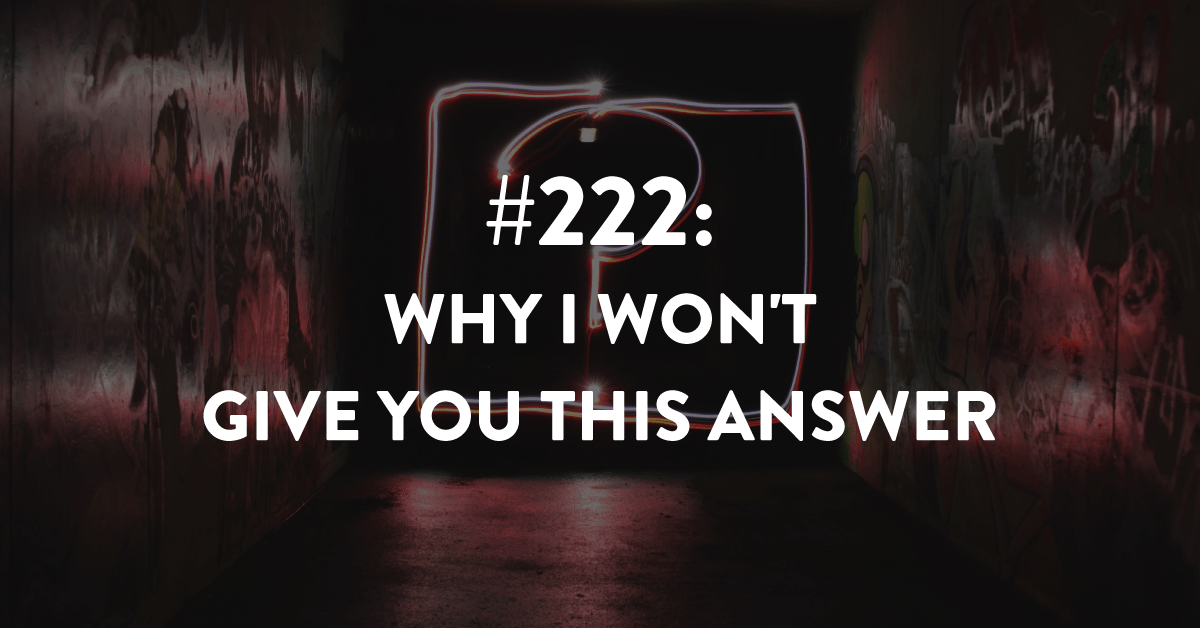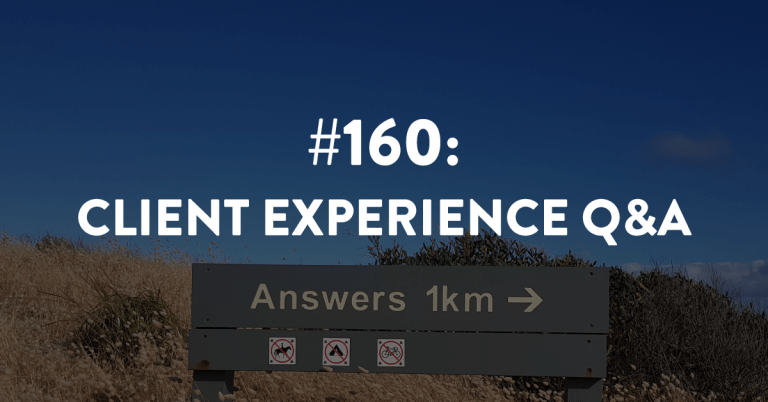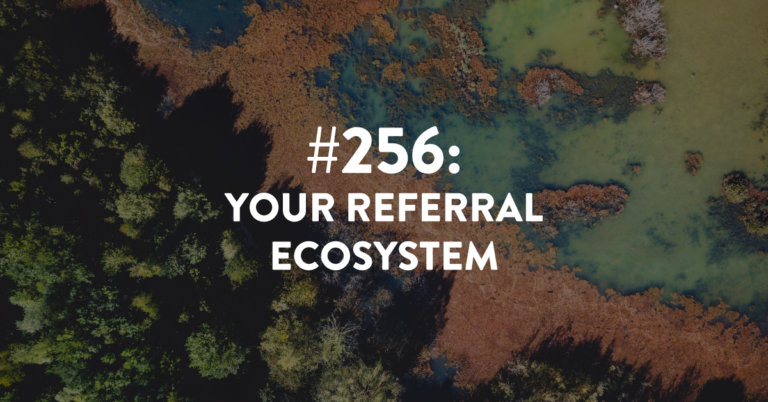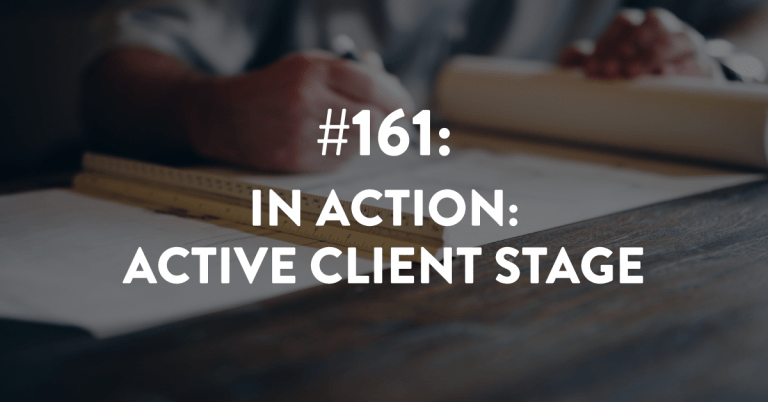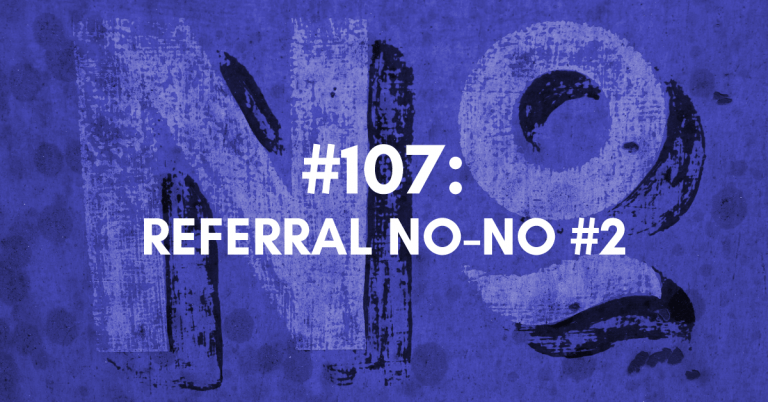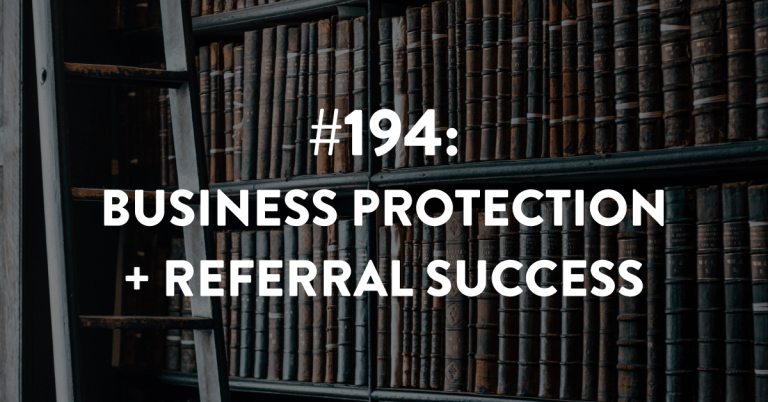Ep #222: Why I Won’t Give You This Answer
“What do I need to do to take care of my referral sources the right way?”
It’s one of the most asked questions that I don’t answer, and there is a very specific reason why. I teach a number of different strategies that are foundational to the success of your business. I also teach strategies that are situational and next level. These strategies are generally for existing or current referral sources, not potential referral sources.
If I give you a referral plan of touchpoints without knowing anything about your specific business or clients, it will not be customized to your actual referral sources—and, therefore, it will not work. These touchpoints must be based on who your referral sources are. It must be personalized. So, let’s dive into how to make this a more unique experience for each of your referral sources.
Looking for Referral & Client Experience Resources:
Take the Referral Ninja Quiz to test your skills and abilities at generating referrals. (FREE)
Buy my book – Generating Business Referrals Without Asking – and learn how to generate referrals through my 5 steps. (LESS THAN $16)
Consider joining Building a Referable Business™ – a unique way to learn all of my referral strategies and tactics with ongoing weekly access to me to answer your questions and help hold you accountable! Check it out and submit your application today!
Coming Up:
Next episode is #223, and we are discussing nuances between repeat clients and referrals and what to know.
Download The Full Episode Transcript
Read the Transcript Below:
Stacey Brown Randall: It’s one of the most asked questions that I receive but I don’t answer. And there is a very specific reason why. Let’s get into it.
Hey there, and welcome to episode 222 of the Roadmap To Grow Your Business Podcast; a show about helping you build a referable business. I’m your host, Stacey Brown Randall.
If you’re a client of one of my programs or a long-time listener to this podcast, or you have just participated in any of the resources and trainings I put out there into the world, you know pretty quickly that I’m not afraid to tell you like it is. I’m not afraid to stand firm in my belief. But because the success is there to back me up, let’s be honest, of how you’re supposed to go about generating referrals.
So, if this is the very first episode that you’ve ever listened to, you may be like, “Whoa, she is a little blunt,” but that’s a little bit about how I am. That is truly how I roll. And I think it’s really important that people understand when I talk about the different pieces of generating referrals naturally, where that comes from, of course. And then, the fact that I’ve been doing this for almost a decade, and I have helped so many business owners achieve referral success.
And so, as you can imagine, every time that people continue to have success, it just cements my foundation even deeper and deeper into that concrete so to speak, about understanding what it looks like to generate referrals.
And with that bluntness, sometimes, it means I have to deliver a message. Maybe not bluntness, let’s go with directness, that sounds nicer.
So, with that directness, sometimes I have to deliver a message that you may not be super crazy about hearing. That’s okay. Doesn’t mean you don’t need to hear it, doesn’t mean I don’t need to give it, but I’ll be honest with you.
I’m human, like everybody else and I prefer people to be happy when they are learning from me. But that won’t keep me from making sure that I deliver something that you need to hear, even if it kind of annoys you as you’re listening to it.
So, this is one of those episodes that you may be like — or my hope is at the end of it, you’re going to have to stay with me to the end on this one.
But my hope is at the end of it, you’ll say, “Okay, you know what? I didn’t really enjoy that episode as much as I would’ve preferred, but the lesson I walked away with made complete and total sense, and I totally get it, and Stacey’s right.”
Because the truth is there is one question that we’re going to tackle today that I get asked probably the most. It is on every presentation, whether that’s live or virtual, I get asked this question. I get asked this question all the time by different podcast host when I’m on their show as well. I get asked this question when I’m doing my own trainings.
And it’s this one question that I always get asked, and I don’t ever answer it directly. And there’s a very specific reason why. So, if this episode annoys you, I hope it also enlightens you, and you understand the reason why, and you understand what that means you need to do moving forward.
So, yes, I’m going to tell you what this question is that I don’t answer directly and why. But I also want you to understand what that means for you as you move forward. So, what’s the number one question that I get that I don’t answer directly? Well, it’s this one:
“What do I need to do to take care of my referral sources the right way?” Meaning, “What should my touch points be?”
Okay, let me back up for a second and tell you where this question comes from. Like why are people asking this question, and then I’ll dive into why I don’t answer it.
So, I teach a number of strategies. Some are what I would refer to as like foundational or signature strategies that I teach. That should be like those strategies that are plans that you have operating in your business on an ongoing basis. That doesn’t mean ongoing like daily. It just means like, hey, this is the strategy I run for referrals, and there’s a couple of them that I teach that I talk about as foundational.
And then on top of the three (and there’s three of them) foundational strategies, then I teach what we call situational strategies, and then another layer of next level.
Well, the situational and the next level strategy, they’re much more nuanced to specific scenarios. So, it’s if you’re not getting the quality referrals you want, how do you have a conversation with your referral source to send you better quality clients, to send you better quality referrals?
So, some of them are very situational. So, we refer to all the strategies that kind of stack on top of the foundational strategies. We talk about those as situational and next level. And they’re things that sometimes you don’t need them all, and sometimes you only need a couple. And sometimes, as your business grows and evolves, you’ll grow into needing more of them.
But there’s kind of this foundational point of these three foundational strategies. And typically, when I am teaching or you’re reading my book, because my book is “Generating Business Referrals Without Asking,” it’s specific to this strategy as well.
So, sometimes people have this question after they read my book. Or if I’m actually giving a presentation or answering a podcast host, I’m being interviewed by them or I’m giving a presentation and I’m talking about one of the first things you need to do, is identify your referral sources. And that kind of directs you into the strategy that you start with.
And so, the strategy that I’m typically teaching when people ask that question, “Hey, what should my touch points be?” It’s the strategy specific for existing or current referral sources. So, it’s the people who have referred you before.
This is not potential referral sources. This is not that client who you love and loves you, and you just really wish they would refer you. That’s a potential referral source. Maybe it’s a client, maybe it’s a COI, maybe it’s somebody in your network.
But this is specific. The question I get specifically when we’re talking about existing referral sources and what do I do to generate more referrals from them consistently, and on an ongoing basis. So, this question about what do I need to do to take care of my referral sources the right way, meaning, what should my touch points be — it’s specific because you believe you have referral sources and now you want to understand how we’re taking better care of them.
How are we going to get more referrals from them, because they have shown a propensity to refer you because they’ve done it before. So, the strategy where I talk about touch points specifically as it relates to a referral plan is in the existing referral source strategy, which the training for those of you who are my clients, you guys know this; but for the training, it’s specifically called Growth By Referrals.
And Growth By Referrals, of course, is a standalone program. It’s a self-study online program that anyone can go through if they believe they have referral sources and they want to go through the process of identifying them, and then building out the right plan.
And then, of course, using the right language, and then tracking their results to be able to get more referrals from their referral sources by implementing this strategy. And, of course, it’s a part of building a referral business. It’s actually a starting point within building a referral business for most people, because it’s our business’ low-hanging fruit.
If you have referral sources, it is your business’s low-hanging fruit to be able to get more referrals from them just by taking care of them the right way if you haven’t been, or just by making sure that you have a process that continues to take care of them so they just don’t stop referring you.
And so, it’s within this strategy when I’m talking to folks about their existing referral sources and then how we take care of them, where this question comes up of like, “Okay, so how do I take care of my referral sources the right way? Meaning, what should my touch points be?” And here’s why I don’t answer that question directly.
I never answer that question, “Well, you’re going to do this, then this, then this, then this, and here’s touch point 1, 2, 3, 4.” I never answer that question in that way. And I know people want me to. I know they’re like, “Just tell me what to do,” but I can’t. And it’s for a very specific reason. And it’s for a reason that I always say is for your own good even if it frustrates you when you first hear it.
Sometimes I have that flashback déjà vu moment of talking to my children. I’m like, “Why do I have to brush my teeth?” “Trust me it’s for your own good. You should probably brush your teeth every day.”
When I think about it, it’s that kind of way that I talk about the referral strategy for existing referral sources. One of the things I talk about at a high level is that you got to have a referral plan, and it’s typically four to eight touch points throughout a 12-month period though. Most people fall in the five to seven range in their first year.
And it’s that touch point plan as though what we’re going to do to take care of our referral sources, allowing us those moments to deliver language, which we call referral seeds, that we’ll be able to plant in our existing referral sources’ minds as well.
And as you can imagine, the question always comes up “Well, great, tell me what those touch points should be. Give me a couple of examples.” And whereas, I will typically give an example or two because I do want to answer the question because I understand where it’s coming from, I also know the danger in me answering that question fully. So, I don’t.
And I learned this one the hard way, which is why I’m so adamant about not answering that question. And here’s the answer.
When I tell you to do something and you’re listening to me, and you’re like, “Stacey said do this, do this, do this, do this.” And then you go off and do it, and I tell you what your five touch points should be or what your six touch points should be — you’ll take it at face value and you’ll go do those five or six if I were to give five or six examples, so to speak.
But the reality of it is, when I’m giving you examples, I don’t know anything about your referral sources. Because the referral plan of touch points that you build is specific for your referral sources, which means it’s completely contingent on who they are; the relationship you have with them, and the budget you have, whether you have a budget or not. That’s okay, both are good. It doesn’t matter.
But the touch points that you ultimately end up doing are going to be based on who your referral sources are. They’re names, they’re people, and, of course, the relationship you have with them. Is this a new relationship that just started referring you but you don’t really know them all that well? Or is this somebody that you’ve known for 20 years that’s been referring you for the last 2 or 3? Whatever it is, and that’s just two examples.
But the referral plan, the touch points of how you’re going to take care of them is contingent on the who. It’s why the number one thing I always tell people to do when they are trying to figure out, “Okay, I want to take control of my referrals, Stacey. I want to generate referrals naturally the way you teach, what do I do first?” I’m always like, “You need to know if you have referral sources and if you have existing referral sources, you need to know their names.”
Because when you see those names on a piece of paper, it is like in an instant, you start to see humans. Those names first and last names on a piece of paper, on Excel spreadsheet, or whatever. Then you start to realize, “Wait, there’s a person behind that name and I have a relationship with them.” No matter how solid it is or how new it is, there’s a relationship that I have with them.
And then we have to take into account the budget you have. And I know there’s a lot of strategies out there, that’s like, “Hey, buy a bunch of gifts and just give people gifts. And then they’ll always, remember you. Give them a gift with your name on it.”
Well, no, not really. And that’s another episode for another time and I’ve talked about how promo swag is killing your referral strategy, so you shouldn’t do it. But I’m not going to talk about that right now.
I know there’s a lot of other strategies out there where you’re taught to do different things. And it’s very prescribed by this number of gifts in a year for your referral sources, or this is who you’re going to ask for referrals, this is when you’re going to ask for referrals. And this is exactly what you’re going to say when you’re asking for referrals.
Again, of course, you guys know I don’t prescribe to that as well. Because I think that’s terrible to ask for referrals. But a lot of strategies out there are very much do this, do this, do this. And they are one-size-fits-all.
And when you really understand the human dynamic and the psychology and the science behind having referrals happen with your referral sources, at the end of the day, it has to do with who those people are. And I don’t know your people. And a lot of times you don’t know your people.
And so, it’s really important if you don’t know your people to know your people first, before you decide ultimately, what you’re going to do to generate more referrals from them, to take care of them in the right way so that you can plant the right type of referral seeds.
So, I think it’s really important that folks understand when you say, “Well, just what are my touch points? What should I be doing?” And I push back and I’m like, “Well, you need to know something about your referral sources to make a decision.” Let me give you a very specific example of how I’ve learned this the hard way.
So, in the past, like very, very, very early on, people would say, what are my examples? And so, I would give one or two examples. You may, if you’ve been a long-time listener of this podcast, or if you’ve heard me on another podcast, this is kind of like my standard example because I know it’s the one that you can kind of visualize in your mind and you get my point.
And the one example I typically give is this example of the Wonder Woman water bottle. So, maybe you’ve heard this story before. But when I was looking at who my referral sources are, and I realized 80% of my top referral sources were business owners who were also parents.
So, I decided to recognize Mother’s Day and Father’s Day for my referral sources. And for my Mother’s Day, one year, I did Wonder Woman water bottles. That was because I knew something about my referral sources. What if 20% of my referral sources were actually parents? Then I probably would never have picked Mother’s Day and Father’s Day to be a touch point that I did. I did it because there was a majority of them.
And so, that was a way that I could see them. I know who they are, I recognize they’re a parent, and I’m recognizing Mother’s Day and Father’s Day because it’s like who sees that coming right from the person they refer people to? And in some cases, some of my best referral sources are also my clients. So, they definitely don’t see it coming from me in that regard.
And so, that’s why I did it. And I’ve given that example a lot. It’s like the standard example I give. I’m sorry if you’ve heard it more than once and I’m sorry if you’re sitting there thinking, “Tell me more.” I do if you’re a client of mine, I tell you all the things.
But what I don’t have control over is you understanding exactly how to apply that information if I’m not teaching it to you because you’re a client of mine. Because the truth is what if your referral sources are maybe very, very like ginger, like over-generalization right here?
What if your referral sources are majority men in their twenties? What do you do to take care of them? I mean, that’s like a gross exaggeration, but I’m trying to make a point here; what you do as a touch point for men in their twenties that’s very different than what you would do for business owners who are also parents in their thirties, forties, and fifties. It’s just different.
So, who the people are means the touch points are different. Now, do I teach within that foundational strategy of existing referral sources in the Growth By Referrals program, which is also part of Building a Referral Business, my group coaching experience — do I teach specific things to consider? Yes, there is actually a proprietary four-part formula that I teach my clients so that they create memorable and meaningful touch points that work for their referral sources as a whole.
This is not onesies and twosies, “I’ll do this for you, this for you. And now, I’ve got 10 referral sources and 5 touch points, I’m doing 50 things in a year.” No, that’s not how we do it. We do actually do this as the group of folks. But it is by paying attention within that four-part framework that I teach them, is how to think about the science behind what actually creates impact and makes things memorable and meaningful.
And so, there’s a strategy behind it. There’s like four parts to the strategy behind it. And that’s where we go deep into the science about how we trigger feelings and impact the other person. And again, this all has to be genuine because when it’s fake, we all know it and it’s never going to work.
And there’s one thing I know about my clients, they’re some of the most genuine people I know, and they actually do really care about their referral sources. So, they do a really good job taking care of them.
And so, the idea here is for you to understand that yes, there is a framework and a formula behind how I teach what your touch point should be. And to my clients who’re in GBR or Building a Referral Business (BRB), there are examples. There is like a list of the top 10 or 12, I think it is, favorite touch points.
There are examples like sample plans of other business owners who have built out referral plans. You can see what other business owners are doing. There’s like, I don’t know, half a dozen or more than that in there. And then, of course, there’s a lot of ideas given too, and there’s the framework.
But all this is done in my training after you’ve identified who your referral sources are. Because when you can see those names and you can start paying attention to commonalities, then you can understand what you probably want to do for them.
And yeah, there are probably some things you shouldn’t do, and there are definitely some things you should do. Like everybody in my program is putting that foundational strategy into place, there are some specific things that we do.
There’s one touch point that everybody does to start with. It’s called the kickoff touch point, it’s the first touch point. Once you do it once, you never do it again. And then there is one touch point we do consistently every single year. But other than that, if you’re doing six touch points in a year, you still got four to come up with if I’m telling you two of them are going to be in your first year. And that matters that you understand who these people are so that you can actually impact them.
One of the things we teach in that four-part framework, it’s called the platinum principles. And the first platinum principles, it’s got to be all about them. It’s got to be all about your referral sources. What do they need? And this isn’t individual, I got to do these five different touch points for Erin, and then five different touch points for Steven, and then five different touch point for Denise. That’s not what this is.
But it is looking at your referral sources from a commonality perspective and understanding what you can do to take care of them to be memorable and meaningful. So, when people say, “Just tell me what my touch point should be,” my response is, “I’ll give you an example so that you can understand how you should think about this. Insert the Wonder Woman water bottle example.”
And then I’m very clear on the disclaimer of, “But I don’t know who your referral sources are. I don’t know what they have in common. And a Wonder Woman water bottle may not be the best thing for you. So, maybe you shouldn’t do it. What if all your referral sources are guys?” Okay.
So, when you think about this, that’s the reason why I don’t answer that question. It’s because I have answered it in the past and people have taken me exactly at my word and gone and implemented. And then have been like, “Yeah, that didn’t really fit who my people were.” I’m like, “Yeah, because they’re your people and you know better. And you know them better, and I was just giving you examples.”
So, I have learned to stop giving multiple examples because people literally are looking for the easy button. They’re like, “What does Stacey say I got to do? Okay, I’m going to just go do it and see if it works.”
No, I want this to work for you the right way. I don’t want you to waste time on doing touch points that may or may not work. I want you to be really clear on who your people are and then execute on the touch points that are right for them. That’s what I want for you. And to do that, you’re going to have to figure out who your referral sources are.
And here’s the thing; I can’t do that for you. You’re going to have to do that yourself. I can help you do it. You can come on into the Growth By Referrals program and you can join Building a Referral Business, my group coaching experience. And I can personally help you do that, and I can review what you’re doing and make sure you’re doing it right.
So, there’s a way for me to help you, but it isn’t something I’m going to tell you when I don’t know anything about your referral sources.
What people don’t know is whether you come into the self-study GBR program or you come into Building a Referral Business, and then you go through the GBR program – what people don’t know is actually when you identify who your referral sources are, you’re uploading that work into the portal and I’m seeing it. And then you’re moving on to build your referral plan. And then I’m seeing that, and giving you feedback on that.
So, we’re on this journey together. We are doing this together, but you got to do the work first. And it’s really important that you understand that this isn’t a one-size-fits-all approach. There aren’t the five touch points I tell every single business owner to do, because my strategy is different from that. The one-size-fits-all approach, they’re out there if you want them, go get them.
But that’s not what this is because we are going to take care of our people better. We are going to take care of our tribe better. And I think it’s important for folks to understand that. And if this the first time you’re hearing it, well, good. You’re learning it early and getting it right from the very beginning. If you’ve been a long-time listener of this podcast or you’ve read my book and you’ve wondered the same thing, “Just tell me what to do.”
You got to know who your people are first. It’s really, really important. You got to start there. You got to be willing to start there above all else.
So, okay, so box rant over. Hopefully, while this may have annoyed you because I didn’t answer the question; what are the touch points you need to be doing? What are the five, six or seven touch point you should be doing in your first year? Hopefully, you understand the power behind the answer that I gave as to why you’ve got to know who your referral sources are.
Resources and links mentioned that will be available on the show notes page for this episode is staceybrownrandall.com/222. That’s for episode 222.
And of course, remember, guys, the transcripts are there. For some of you, it’s easier just to go read the transcripts from the show notes page or to download them — that’s right, you can actually download the transcripts as a PDF. You can download the transcripts and read them at your leisure.
And definitely, I want to make sure that you know we have something coming up very, very soon. Not talking about it right now, but you’ll start hearing about it on a couple of episodes. Maybe you’ve seen me post about it on social media regarding a retreat, an in-person retreat that’s happening in December.
More details will start coming out for you guys to be able to join me for that. It is specifically for my BRB members, but there’ll be a limited number of tickets available for our folks to join us for part of it, not the whole thing. It’s mostly for BRB members, that’s my Building a Referral Business members.
But more details will start coming out in some future episodes. Keep listening, keep watching social media. If you’re on my email list, you will definitely hear about it, let’s be honest. And I can’t wait hopefully, to meet some of you guys in person in December at that retreat.
So, coming up next week is episode 223. And we’re going to talk about some nuances between repeat clients and referrals that I see people use interchangeably that are actually very different. So, until then, you know what to do, take control and grow your business. Bye for now.
Thanks for listening to the Roadmap to Grow Your Business podcast. To
access all resources and links mentioned in today’s show, and to
connect with Stacey, head over to www.staceybrownrandall.com.

